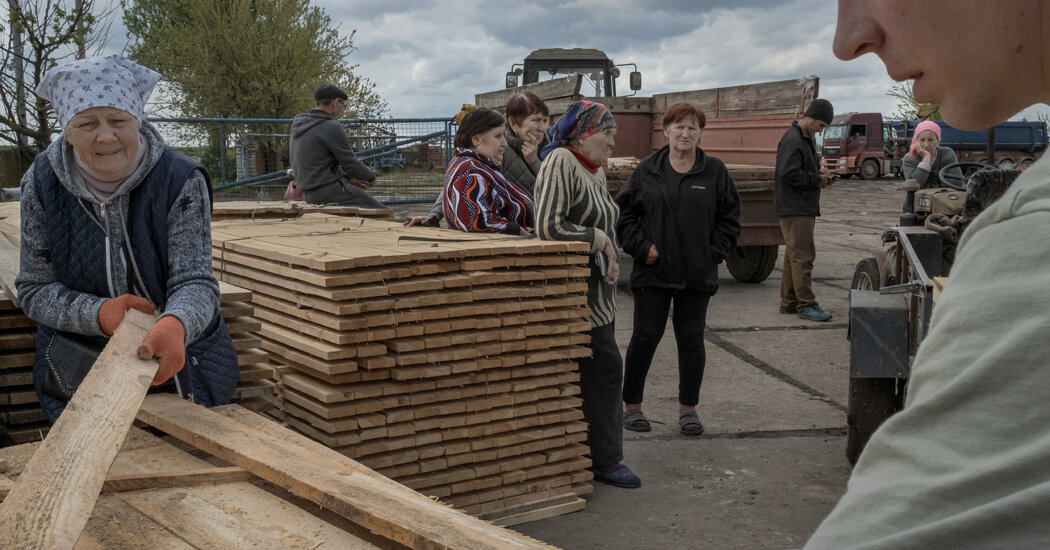A double line of concrete pyramids snakes its way across undulating farmland outside the city of Kherson. Anti-tank fortifications known as dragon’s teeth, the pyramids are a sign of the new defenses Ukraine is building in the south against an anticipated Russian offensive.
In a village nearby, residents were focused on a more immediate task: collecting donations of building supplies.
The people of the Kherson region have been slowly rebuilding their homes and livelihoods since a Ukrainian counteroffensive forced Russian troops out of the area west of the Dnipro River 18 months ago and ended a brutal occupation.
Many have fixed their roofs, windows and doors, yet as they start to plant crops and tend their vegetable gardens, they are bracing for another Russian attack.
“Anything is possible,” said Oksana, who paused from weeding the flower bed in front of her home. Like most people interviewed for this article, she gave only her first name for fear of Russian reprisal. “There is talk of a big attack in May to June. We are reading they will take back Kherson.”
Her two sons joined the army after the Russians were forced out, and were complaining they were short of weapons, she said. “It’s very hard,” she said of the situation at the front.
For those who lived through eight months of Russian occupation, the memories have stoked fears that the Russians would be harsher a second time.
Oksana recounted how her family had lived under the gun of Russian soldiers lodged across the street and how her husband nearly died when wounded in the neck from a shell blast.
“It was scary,” she said. Her face crumpled as she began to weep.
Down the street, a veteran soldier, Oleksandr Kuprych, 63, keeps a shotgun in his greenhouse and said he would use it if the Russians returned.
“I will send the women and children away,” he said. “And I will be here. I have my trench and my rifle.”
In his house, he also has a Russian soldier’s helmet damaged by a long slash from an ax.
Mr. Kuprych said he had killed the soldier with a hatchet and buried him and his rifle in the tree line above the village. The soldier was one of a pair who had shot at the villagers who tried to climb a hill to find a cellphone signal.
“I was so angry that I put all my strength into that ax blow,” he said.
When Ukrainian soldiers recaptured the village, he showed them where he had buried the soldier. They took away the body and rifle but let Mr. Kuprych keep the helmet. The episode was written up in a book on Kherson’s resistance under occupation.
The rural communities of Kherson are resilient but much degraded. Some villages that stood on the front line are so badly smashed that only a few families have been able to come back and fix up their homes. The electricity and gas are back up in most places, but water has to be trucked into some villages. Irrigation canals remain destroyed, leaving farms and businesses largely abandoned.
There are few jobs, and most families are living on handouts. International charities have provided cows to residents and cash for them to buy chickens and seeds.
Some of the largest villages such as Myrolyubivka are humming, swollen with families displaced from frontline communities. Blue tarpaulins are tacked over damaged roofs, and vegetable gardens are neatly tilled.
Yet these villages, less than 20 miles from the front line, remain targets of Russian rockets and bombs. Myrolyubivka recently completed a large underground basement for schoolchildren to gather in twice a week for classes and games. But before work on the basement was finished, Russian missiles struck the local hospital, demolishing a whole wing and several houses.
“Let them die, the bastards,” Tamara, 71, said of the Russian troops as she pushed her bicycle along the street. “I was tending my garden and shells were flying this way and that over my head, and it’s still boom, boom, all the time.”
In another village, the community leader, Lyubov, ran through a litany of destruction from the fighting in 2022. “The school is damaged, the kindergarten is damaged, the house of culture is damaged, and the hospital is destroyed,” she said. She asked that her surname and the name of the village not be published to avoid being targeted further by Russian rockets.
The United Nations and international charities have supplied building materials for residents to repair more than 100 houses in the village, but 50 were beyond repair, she said. “We are waiting for money for that,” she said.
Russian shelling is not the only source of hardship. The destruction of the Kakhovka dam last year, which led to widespread flooding of the Kherson region and the draining of the Kakhovka reservoir, has lowered the water table and left some villages with infected or dry wells.
There are hundreds of hectares filled with mines and unexploded ordnance. Fields lie untended, and white ribbons fluttering from the stalks of weeds warn of mines.
Officials say it will take years to remove the mines, but some farmers say they cannot afford to wait. Some have paid private contractors to clear their fields. Others have taken to sweeping their fields with a metal detector.
“We find anti-tank mines and anti-personnel mines,” a farmer and mechanic, Oleh, 35, said as he bent underneath the engine of his tractor. “It’s the same thing every day. Demining and then sowing.”
His village lay on the front line and is one of the most badly damaged. Only a few families live there, and only 10 children, because there is no school, his wife, Maryna, 33, said.
Beneath the physical destruction lie deep wounds from the occupation.
A ruined two-story house on the edge of the village of Pravdyne served as a Russian position during the occupation. Russian cigarette packets and a ration pack littered the floor amid broken glass and rubble. Burned-out armored vehicles lay beyond.
At the beginning of the invasion, Russian troops killed six guards from a farming company and a 15-year-old girl who was with them, blowing up the house they were staying in. Investigators exhumed their bodies after the occupation and found two of them had been shot in the head, according to details released by the Kherson Regional Police. The filing cited a man serving in the Russian Marines for his role in the killings.
Many families have men at the front or have lost relatives to the war. “Who will answer for it?” said Naira, a psychologist whose niece’s husband was killed in the fighting.
While a proportion of the urban population in southern and eastern Ukraine has Russian roots, the rural population is overwhelmingly Ukrainian. Few villagers worked for the Russian administration during the occupation. Some departed with the Russian troops. Others were charged with collaboration and imprisoned by the Ukrainian authorities, said a farmer, Viktor Klets, 71.
But divisions were showing in the remaining community in petty jealousies and complaints over the amounts of compensation people were allotted, he said.
There were still Russian sympathizers in the village, but they were keeping quiet for now, Mr. Klets said. There was solidarity among those who survived the occupation together, but others who left and then returned have accused them of robbing their houses, he said.
“The war changed people,” said Lena, 45, a neighbor, standing beside him. “It made people more mean.”
As for the future, villagers often quote the same proverb. “Life is like a long field,” Mr. Klets said. “Anything could happen along the way.”
Yurii Shyvala contributed reporting from the Kherson region.



